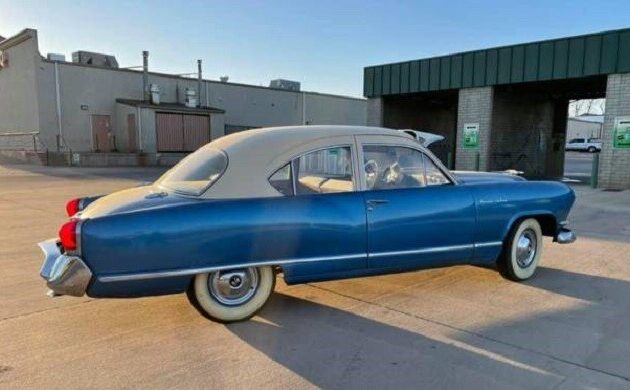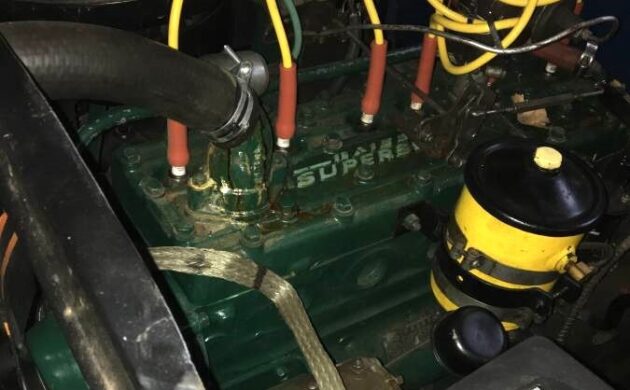1 of 1,315? 1952 Kaiser Manhattan 2-Door
Kaiser-Frazer Corp. was the result of a merger of two automotive independents in 1947. The Manhattan was the top-of-the-line car within Frazer until that brand was discontinued in 1951, after which the Manhattan lived on for two more years with Kaiser branding. This ’52 Manhattan looks to be the 2-door sedan (not the Club Coupe) of which 1,315 copies were made, making it rare when new and even rarer today. Located in St. Paul, Minnesota, this likely survivor has been released from long-term storage and is said to run well. It’s available here on craigslist for $6,500, another tip brought our way by Barn Finder T.J.!
Independents struggled after World War II while the major builders (GM, Ford, and Chrysler) were all flourishing. As a well-equipped automobile, only 17,417 Manhattans were built in total in 1952, though demand would pick up a bit to 29,945 in 1953. Perhaps that was a big deal to the likes of Kaiser-Fraser, but a drop in the bucket for the “big boys” who could sell almost anything they built in the five years after WW2.
These early 1950s Manhattans were known for their unique styling which included “dips” in the sidelines and rear window. They were powered by a 226 cubic-inch “Supersonic Six” that produced 115 hp. While a 3-speed manual transmission was standard, most of the ’52 Manhattans were sold with an optional 4-speed Hydra-Matic that was obtained from General Motors. We’re told this vehicle runs and shifts as it’s supposed to even though it was stuffed away for a time. New parts include the gas tank and master brake cylinder.
The two-tone paint may be quite nice, but it’s hard to tell with the variety of photos provided. We’re told it’s a “solid car with minor rust” but we don’t know where any of the problem areas may be. The same may be said for the interior as the photos don’t help a lot either. The car is pictured with two different sets of tires. At 63,000 miles, this automobile may be a solid find. Notice the positioning of the door posts in almost the middle of the interior, meaning it might be a challenge climbing your way into the back seat.
Auctions Ending Soon
 1969 Ford MustangBid Now9 hours$1,050
1969 Ford MustangBid Now9 hours$1,050
 1965 Ford Falcon Station WagonBid Now3 days$2,300
1965 Ford Falcon Station WagonBid Now3 days$2,300
 2002 Jaguar XK8 ConvertibleBid Now4 days$4,250
2002 Jaguar XK8 ConvertibleBid Now4 days$4,250
 1979 Chevrolet Camaro Z/28Bid Now5 days$4,500
1979 Chevrolet Camaro Z/28Bid Now5 days$4,500
 1960 Dodge D300Bid Now5 days$300
1960 Dodge D300Bid Now5 days$300





Comments
Okay.. I know it’s late (see time stamp), but this car has two different styles – left side has thick (above the) rocker panel trim with fender skirts, narrow whitewall tire on front and white letter on back. Right side has thiner molding without fender skirt, and wide white walls. Oh, wait – now the left side matches, in the first of the second row pictures (but now the paint is off).
Yes of course, I’ve heard of before-and-after, but no mention of new matching tires. And, this is the Manhattan, so it should have wide trim with skirts.
This car, in pictures, reminds me of the Dick Tracy comic nemesis Two Face – (and a Kaiser is a perfect brand of auto for the setting in the Tracy world, by the way.)
So, tell me – did the seller pilfer the goods for his own project?
Optical illusion. Both sides have the narrow trim. No fender skirt. This is a Deluxe, not a Manhattan. The padded dash is what the Deluxe used. The Manhattan would be the stimulated bamboo.
There are two different cars in the photos on craigslist, which ones for sale?
There’s no optical illusion – click on the picture above to see the notes on this ‘before’ picture. Driver’s door has hole for a mirror, and that trim is wide. Other pictures show the mirror hole filled and painted – the blue does not match.
I’ve got to say, Russ brings some really neat vehicles to light. Many, I’m sure, younger readers never heard of. By the 60s, Kaiser name was fading fast, but after the war, yeah the one nobody cares about anymore, Dubja, Dubja 2, der, Kaiser was a respected name BECAUSE of its war efforts. We couldn’t have done it ( won) without them. Russ didn’t mention that Kaiser was a leader in auto safety. Better visibility, padded dash, low center of gravity, were just some of the standard features that all the car makers adapted,,,eventually. Got to love the “Supersonic 6”,,,hardly, the tried and true Continental, but it worked, and that’s all that was required. The automatic is a huge plus, and this won’t be around long. Great find.
Kaiser didn’t win the war, the Ruskies did. They took Berlin on their own and with the war in Europe won they opened a front in China against Imperialist Japan. Hiroshima and Nagasaki were just a heads up to the Soviet union.
ps I hate communism. God bless America. Sincerely, your appreciative neighbour to the north.
pss We were in it since ’39.
You were in it since 1916. Read -The Forced War- it´s available through Amazon.
Kaiser never did anything cheap, here. And this carried on through his Jeep endeavor…Kaiser-Frazer (which was never a merged company) gave up on braking into the mainstream auto market, at the same time Willys-Overland was about to enter a second bankruptcy. Henry Kaiser (Joe Frazer having left, angrily) still didn’t understand the consumer market, but he sure knew government contracting. And W-O had the lucrative contract for 1/4-ton transport vehicles – the military jeep.
Kaiser, failing to break into the general auto market, closed out his auto operations (which included a large inventory of unsold product, one reason K-F was in trouble, and why there were “1955” Kaisers still being sold a year after the factory was closed)…
…and sent the tooling, for Kaiser and Willys products, down to a new Kaiser Industries subsidiary in Argentina. The Kaiser plant at Willow Run was sold to GM, after a disastrous fire at the Hydramatic plant. The reconstituted Willys Motors, owned by Kaiser Industries, focused on Jeep-related products.
For a time. In a few years the company had changed its name to Kaiser Jeep Corporation, had introduced the carlike J-series Wagoneers…and was again offering more against the Big Three in light-truck marketing. The Wagoneer et al, was so advanced it ran unchanged under three corporate owners until 1990 – something even Chevrolet couldn’t do with their long-lived Squarebodies.
Jeep, under Kaiser, was offering the Turbo-Hydramatic three-speed transmission in trucks, when at the time, Chevrolet only offered the Powerglide on a truck, and Ford, the crude-by-comparison Borg-Warner-based Ford-O-Matic. Padded dashes were standard, in a time when Chevrolet painted all their truck interiors a tasteless silver.
Yes, the Kaiser cars and later trucks, did try to deliver value – with some success. Kaiser failed, former CEO Edgar Kaiser admitted later, for simple lack of adequate capitalization. They were trying to hit the ground running, but even Kaiser industries, with several profitable business lines, couldn’t come close to raising the money needed just to operate in that world.
it says “Deluxe” on the fender, which is the model above the Special for that year. Also a Manhattan would have a wide stainless trim strip along the sides.
The engine was basically a Continental Combine Red Seal engine, sourced by Kaiser. While making decent power, it wasn’t enough for these big cars. And its distributor pedestal was known for breaking so it’s not unusual to see an engine with the distributor wired in place.
Kaiser built its own engines.
Yes and no. Kaiser built Continental motors with some modifications under contract, I believe.
Kaiser-Frazer began as a dream for a new post-war Graham and was soon joined by the Kaiser interests which had planned for its own post-war automobile.
Also, the Kaiser Manhattan lasted into 1955.